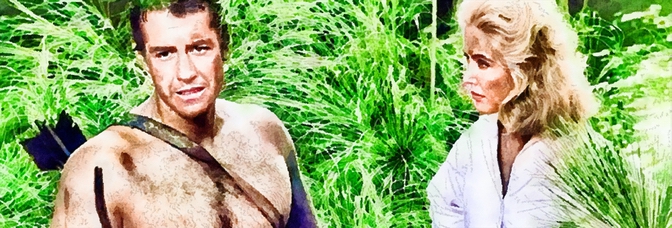Tarzan’s Greatest Adventure is a fairly solid action thriller. Tarzan (genial, musclebound Gordon Scott) is hunting nemesis Anthony Quayle through the jungle. The movie opens with Quayle and his crew robbing an African settlement. They’re after the dynamite but they end up killing a couple people. They’re also in blackface, which would just be a dated oddity if you didn’t realize they were in blackface until one of them is deliberating the fate of an actual Black person, a sick African child. It’s this really weird moment in the film and it’s the first really memorable sequence. Greatest Adventure seems a little different from the start.
So the gang. Sean Connery is the cocky, rough and tumble one, Niall MacGinnis is the nerdy Dutch one (he’s the diamond guy—turns out it’s all about diamonds), Al Mulock is the secretive boat driver, Scilla Gabel is Quayle’s woman. Connery and Gabel are flirty but it’s never a thing for Quayle because Quayle’s so secure. Connery worships him, MacGinnis is terrified of him, and Mulock respects him. Because Quayle and Mulock are the older guys who aren’t shifty Dutchmen or cocky heartthrobs, they’ve got the experience. Half of Greatest Adventure is this “after the heist” movie, just set in Africa on a questionable boat. There are certain exterior shots where the boat looks really fake. And I think always when it’s on a set. And now I guess I better just get the set-talk over with.
Greatest Adventure has profound production deficiencies. Director Guillermin and cinematographer Edward Scaife are mixing location shots from two obviously different locations—usually with a jump cut courtesy Bert Rule—but Guillermin and Scaife also have some set shots, then some projection composites, then stock African safari footage. And then Rule’s jump cuts. And Guillermin’s composition. He’s so close on it, every time. The way he shoots leading lady Sara Shane ruins her performance. Well, okay, Rule’s cutting probably hurts it worse, but Guillermin has a very strange way of shooting Scott and Shane—like he doesn’t trust them with the scene, and then when they succeed (occasionally with qualifications, yes, but still success), Guillermin doesn’t acknowledge it. Scott and Shane have this relatively effective love affair in this tense experience. Because Shane didn’t mean to tag along with Scott, she just wanted to be a jerk to him—Shane’s a model but mostly just a special friend to a very rich guy. The characterization of Shane and Gabel—their character setup—is not great. But Gabel and Shane get caught up in the events—Scott hunting Quayle, Quayle deciding to hunt him right back—and both women start their own character arcs, totally separate from the boys.
It’s cool. Even with all the issues.
Scott’s fine. Well, until the end when he needs to carry the movie, even for a moment and he can’t, but he’s fine. Even with the goofy dialogue. He’s got very goofy dialogue to show he’s Tarzan and not some regular dude. Formal but grammatically incorrect or something. But it’s all about Quayle. Quayle gives a truly superb performance. He gets to Ahab out, he gets to bare his soul, he gets to handle the mundane personality conflicts between his crew, he gets to have this weird but sincere romance with Gabel. Quayle takes the role as written and adds all sorts of depth to it. Guillermin helps a lot with adding texture—with the bad guys, anyway—but it seems like Quayle’s out there on his own and Guillermin is just getting to watch like the rest of us. It’s a great villain performance. And rather grounded, especially considering it’s Tarzan’s Greatest Adventure.
It gets good for a long while, then the end fumbles. Badly.
But Guillermin tries a lot and some of it succeeds. Quayle’s legitimately fantastic performance, for example.

Leave a Reply